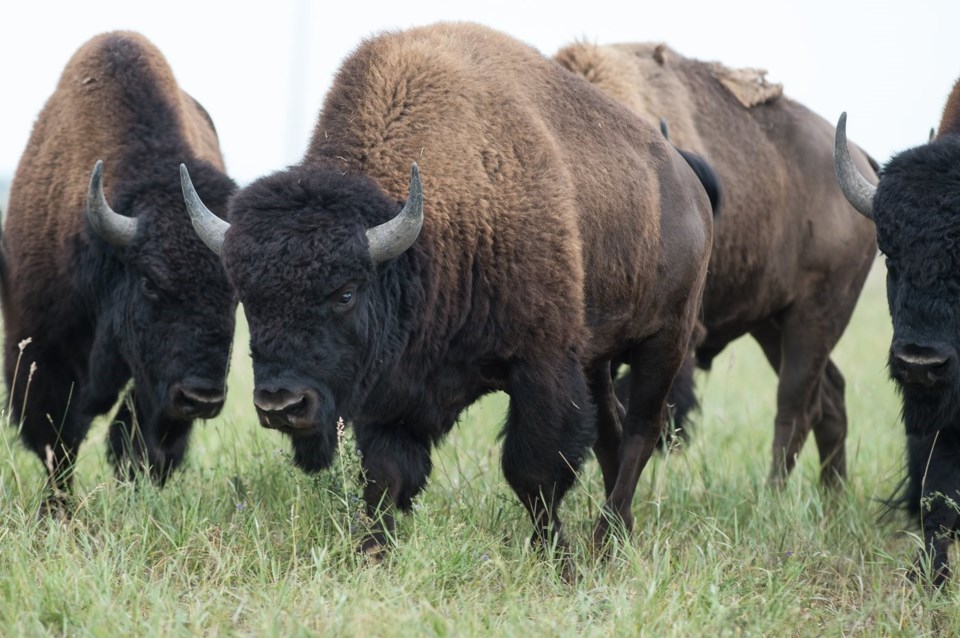MUSCOWPETUNG SAULTEAUX NATION — While COVID-19 outbreaks are forcing Saskatchewan’s Hutterite communities to pause or adjust long-held traditions, at the Muscowpetung Saulteaux Nation, the pandemic is a chance for the community to reconnect with its traditions and ensure a stable food supply, if a lockdown scenario is needed.
The First Nation, about 60 kilometres northeast of Regina, has introduced on to its land 15 buffalo, all to be slaughtered if Muscowpetung or neighbouring First Nations need food in the event they have to close access to their communities to contain a viral spread.
Newly elected chief Melissa Tavita made it her first task, with help from Muscowpetung’s councillors and elders, after band members elected her to the post in April.
Among the helpers was public safety, security and fire supervisor Jim Pratt.
“Some of the options were cattle and buffalo," Pratt said of the plan's initial stages. "And the discussion was bringing back the buffalo to our territory and using them as a food source, and ... possibly keeping it as a farm down the road."
Tavita said Muscowpetung’s leadership eventually found a rancher north of Medicine Hat, Alta., from whom they bought the 15 males, all two to three years old.
Prior to her election to chief, Tavita served several years as a councillor for Muscowpetung; she said a backup plan was always in her mind since the early days of the pandemic in late March and early April.
“Five to seven freezers,” is how far one buffalo can go in terms of supply, she said.
At almost 1,000 kilograms in weight, males are considerably larger than their 600kg female counterparts.
Tavita said she and the Alberta rancher are working out details for the next phase of the band’s bison plan, bringing in female calves to be used for breeding in the future to grow the herd’s population.
Those calves will be donated, she said.
For now, the 15 boys are in a four-acre pen owned by the community at the top of the Qu’Appelle valley, chomping down alfalfa and broom grass, making regular patties as they go.
Returning the bison to Muscowpetung land also completes an historical circle for the community, albeit an imperfect one: The animal was nearly wiped out on the North American Great Plains, thanks in part to starvation policies directed by the John A. Macdonald government at Plains Indigenous peoples, in what was then the Northwest Territories in the 1800s.
Such importance wasn’t lost on Pratt.
“We grew up learning and listening to stories about this animal that our ancestors survived on. So that's where it (discussion) took off from: To bring them back to our care here, because they once roamed our beautiful Qu'Appelle Valley,” he said.
Along with sustenance, the Muscowpetung Buffalo are to serve an educational function for the community’s youth. It was a point Pratt emphasized while his grandchildren played and laughed in the background.
Part of that education will inevitably include the tough parts, the ones about near-extermination and starvation in the 1800s.
“I guess if there's a message there, (it’s) when you're trying to kill something forever, which happened to these animals, it is through strength and caring we're able to bring them back … we're able to say ‘we're survivors and they've survived.’ Now they're coming back, we're bringing them back to help us survive even more,” he said.
Their presence has also prompted Pratt to reconnect with his spirituality, a process he says other community members are doing, too.
“They (the buffalo) give strength to pray to the creator,” he said, adding the animals are not idols; more like providers of support.
Chief Tavita said Muscowpetung has not recorded any cases of COVID-19 so far, saying that’s for on-reserve members.
The community has 1,506 registered members; Tavita said none of Muscowpetung’s members living off the First Nation have called to report infections.



